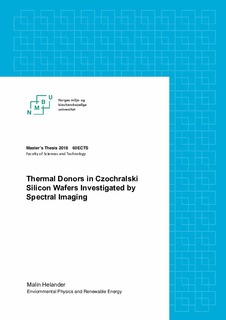| dc.contributor.advisor | Burud, Ingunn | |
| dc.contributor.advisor | Olsen, Espen | |
| dc.contributor.author | Helander, Malin Iris | |
| dc.date.accessioned | 2018-06-06T09:28:14Z | |
| dc.date.available | 2018-06-06T09:28:14Z | |
| dc.date.issued | 2018 | |
| dc.identifier.uri | http://hdl.handle.net/11250/2500553 | |
| dc.description.abstract | In oxygen rich CZ-material, thermal donors (TD) are formed at elevated temperatures of approximately 450°C. They are electrically active clusters of interstitial oxygen that act as double donors to the conduction band. In material that is exposed to higher temperatures donor concentration is reduced and it has been shown that it only takes a short time annealing at temperatures of 650°C to eliminate TDs. By investigating the creation and dissociation of these electrically active centres a fundamental knowledge of oxygen diffusion at elevated temperatures can be found. A study was performed on these electrically active centres with the use of hyperspectral photoluminescence imaging. The method gives both the spectral and spatial resolution of the defect luminescence present in the material. For the study, as cut samples from CZ-silicon material with high and low oxygen was selected. All the samples were exposed to thermal annealing in the range of thermal donors under different conditions. Additionally, a short time anneal was performed at 650°C with the purpose to eliminate possible thermal donors. The annealing was executed in multiple steps to see if a development in the spectral and spatial distribution could be seen with time. It was found that the spectral response in the samples changed drastically with annealing time at temperatures of 450°C. Multiple emission lines was found exhibiting photon energies between 0.66-0.767 eV and the intensity of these emission lines developed significantly with anneal time. The 0.767 eV emission line has been denoted as the P-line in other experimental work. Multiple new emission lines could also be seen in the spectral response at among others 0.807 and 0.9251 eV, and these are known from literature as the D1 and H line. The thermal annealing at 650°C resulted in the disappearance of almost all emission lines in the spectral response besides the P-line. These results show that long time annealing in the temperature range of thermal donors influences the spectral and spatial distribution of defect luminescence in CZ-material and that the method used in this study is suitable for tracking these changes. | nb_NO |
| dc.language.iso | eng | nb_NO |
| dc.publisher | Norwegian University of Life Sciences, Ås | nb_NO |
| dc.rights | Navngivelse-Ikkekommersiell 4.0 Internasjonal | * |
| dc.rights.uri | http://creativecommons.org/licenses/by-nc/4.0/deed.no | * |
| dc.title | Thermal donors in Czochralski silicon wafers investigated by spectral imaging | nb_NO |
| dc.type | Master thesis | nb_NO |
| dc.subject.nsi | VDP::Teknologi: 500 | nb_NO |
| dc.description.localcode | M-MR | nb_NO |

